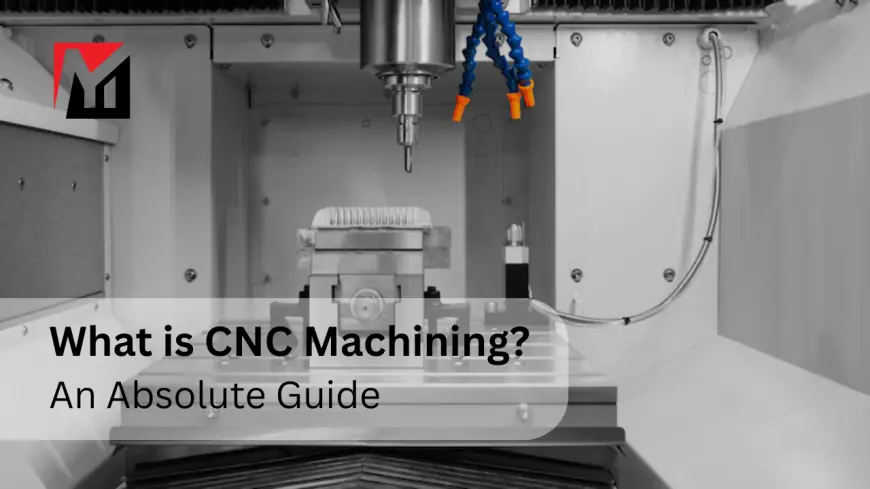CNC Machining: Driving Innovation in Precision Manufacturing
Explore how CNC machining enables precise, scalable manufacturing across aerospace, medical, automotive, and more. Learn how this automated method delivers unmatched quality and efficiency.

Precision, speed, and consistency—these are the pillars upon which modern manufacturing stands. As industries grow increasingly complex, manufacturers need a method that can meet tight tolerances while maintaining efficiency across prototyping and full-scale production. Enter CNC machining a highly advanced, automated process that is transforming how parts are fabricated across aerospace, medical, automotive, and other demanding sectors. This article explores what CNC machining is, how it works, and why it remains indispensable in today’s competitive industrial landscape.
What Is CNC Machining?
CNC (Computer Numerical Control) machining is a subtractive manufacturing process where computers control the movement of machining tools. These tools—such as mills, lathes, drills, and grinders—remove material from a workpiece to shape it into a finished part according to digital design specifications.
The process is controlled by G-code, a specialized programming language that directs tool paths, speeds, and feeds. CNC machines can operate on 3, 4, or 5 axes, making it possible to produce highly complex parts with incredible accuracy. CNC machining is versatile enough to handle one-off prototypes and high-volume production runs, making it a go-to method in precision engineering.
How CNC Machining Works
The CNC machining process follows a structured workflow to ensure high-quality, repeatable results:
-
CAD Design
The part is first created as a 3D model using Computer-Aided Design (CAD) software. -
CAM Programming
The CAD model is converted into machine-readable instructions using Computer-Aided Manufacturing (CAM) software. These instructions form the G-code. -
Machine Setup
The raw material (metal, plastic, etc.) is mounted on the CNC machine. Appropriate cutting tools are selected and installed. -
Machining
The CNC machine removes material from the workpiece by following the G-code instructions. Depending on the operation, this may involve milling, turning, drilling, or grinding. -
Finishing and Inspection
Once machining is complete, parts may go through secondary processes like polishing or deburring. Inspection using precision tools ensures the part meets all design specifications.
Types of CNC Machining Processes
CNC machining is not limited to a single method. Common techniques include:
-
CNC Milling: Uses rotating cutting tools to remove material from the surface of a stationary workpiece.
-
CNC Turning: Rotates the workpiece against a stationary cutting tool—ideal for cylindrical parts.
-
CNC Drilling: Produces accurate holes in precise locations.
-
CNC Grinding: Achieves ultra-smooth finishes on hardened materials.
-
EDM (Electrical Discharge Machining): Cuts hard materials using electric sparks.
Each of these processes serves different applications but collectively allows manufacturers to create almost any shape or feature with high repeatability.
Advantages of CNC Machining
1. Precision and Accuracy
CNC machines operate with extreme precision—often to within ±0.001 inches—making them ideal for industries where accuracy is critical. Parts come off the machine exactly as designed.
2. Repeatability
Once programmed, CNC machines can produce identical parts over and over, ensuring consistency even in large production runs.
3. Material Versatility
CNC machines can process a wide variety of materials, including:
-
Metals: Aluminum, steel, brass, titanium, copper
-
Plastics: ABS, Nylon, PEEK, Delrin
-
Composites: Carbon fiber, fiberglass
This adaptability makes CNC machining suitable for everything from aerospace components to consumer electronics.
4. Efficient Turnaround
Automated tool changes, minimal manual input, and optimized tool paths allow CNC machines to run quickly and continuously—often 24/7 in high-production settings.
5. Complex Geometries
Multi-axis machines can produce intricate parts with undercuts, curves, and other features that would be difficult or impossible to achieve manually.
6. Reduced Human Error
Automation minimizes operator involvement, drastically lowering the risk of production errors and part inconsistencies.
Industries Using CNC Machining
Aerospace
Precision is paramount in aerospace applications. CNC machining is used to create structural components, engine parts, brackets, and housings that must withstand extreme conditions and meet regulatory standards.
Medical Devices
Medical manufacturers rely on CNC machining to create surgical instruments, orthopedic implants, and diagnostic equipment that meet strict hygiene and dimensional tolerances.
Automotive
From transmission housings to dashboard enclosures and engine components, CNC machining supports the automotive industry’s need for performance, safety, and cost-efficiency.
Electronics
CNC machining allows for the creation of small, intricate components like heat sinks, housings, and connectors used in consumer and industrial electronic devices.
Defense and Military
Mission-critical parts for defense systems require strength, accuracy, and reliability. CNC machining ensures compliance with stringent military specifications.
Industrial Equipment
Heavy-duty machinery components—such as gears, shafts, and hydraulic systems—are commonly CNC-machined to ensure durability and performance under stress.
CNC Machining vs. Other Manufacturing Methods
When compared to other techniques, CNC machining stands out in multiple areas:
| Method | Strengths | CNC Advantage |
|---|---|---|
| 3D Printing | Rapid prototyping | Better strength and precision |
| Manual Machining | Low-cost, small batch | More efficient and scalable |
| Injection Molding | Mass plastic part production | CNC is ideal for prototypes and metals |
| Laser Cutting | 2D shapes on sheet materials | CNC supports 3D components |
CNC machining offers unmatched flexibility and performance for a wide range of applications.
Selecting the Right CNC Machining Partner
To fully leverage CNC machining, it’s essential to choose a capable service provider. Key factors include:
-
Machine Capabilities: Ensure they offer 3, 4, and 5-axis machines and can handle your material and design requirements.
-
Quality Control: Look for shops with ISO certifications and advanced metrology tools for inspection.
-
Experience: A provider with industry-specific knowledge will deliver better results and faster turnaround.
-
Design Support: Providers that offer DFM (Design for Manufacturability) assistance can help reduce costs and improve part performance.
-
Scalability: Your provider should be able to handle both prototyping and production volumes as your project grows.
Future Trends in CNC Machining
CNC machining is evolving rapidly thanks to innovations in technology:
-
Smart Factories: IoT-connected machines that enable predictive maintenance and real-time monitoring.
-
Artificial Intelligence: AI-driven optimization of tool paths, speed, and energy consumption.
-
Lights-Out Manufacturing: Fully automated, unattended production using robotic loaders and automated tool changers.
-
Sustainable Practices: New energy-efficient machines and eco-friendly coolants are making machining more sustainable.
These trends are driving CNC machining into a new era of efficiency, precision, and innovation.
Conclusion
CNC machining is more than a manufacturing method—it’s a strategic advantage for companies aiming to innovate, scale, and maintain the highest standards of quality. Its ability to produce complex, high-tolerance parts from a wide range of materials makes it essential in industries from aerospace to electronics.
With fast turnaround times, scalable production, and unmatched accuracy, CNC machining empowers manufacturers to meet modern demands while positioning themselves for future growth. Partnering with an experienced CNC machining provider ensures you’ll stay ahead in a competitive and rapidly evolving industrial world.
What's Your Reaction?
 Like
0
Like
0
 Dislike
0
Dislike
0
 Love
0
Love
0
 Funny
0
Funny
0
 Angry
0
Angry
0
 Sad
0
Sad
0
 Wow
0
Wow
0





















































